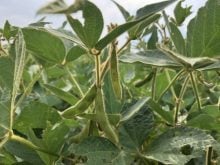(Resource News International) — With a week of September already gone, producers on Canada’s Prairies are beginning to fear frost may affect their crops that have yet to be harvested.
But just how will the crops be damaged? Bruce Burnett, director of weather and market analysis for the Canadian Wheat Board in Winnipeg, said a swathed crop can usually take frost better than those that are still standing.
“A swathed crop would tend to be a bit more protected,” Burnett said. “Part of the protection is that you are starting the drydown process.”
Read Also

Pulse Weekly: SPG looks back at harvest, ahead to trade
Saskatchewan Pulse Growers executive director Carl Potts said this year’s harvest had strong yields as the organization now works on international trade.
Although swathed grain generally handles the cold better than standing grain, Burnett said producers shouldn’t rush to get the crop swathed just so it’s down when the temperature dips below 0 C.
“If you’re swathing it too early, it’s going to have an effect on the crop anyway,” he said.
According to Larry Flysak of Environment Canada in Saskatoon, there is a solid chance of frost for the next day or two across the Prairies, particularly in eastern Saskatchewan and Manitoba.
“When you get in the double-digit days of September (Sept. 10 and on), you get to see about a 50 per cent chance of frost, and we are about at that point,” Flysak said.
The bulk of damage occurs when the temperature hits the -2 C mark, Burnett said. When the thermometer is in the 0 C to -1 Crange, damage is usually just seen in low-lying areas.
Damage from frost is usually found in the quality of the product, but if it hits while the crop is still in an immature state, yield will be affected more. Frost interrupts the filling process, Burnett said.
While no crop can handle frost well, and most suffer similar losses, there are some crops that take frost worse than others, depending on their stages.
“Immature canola would be a bit more susceptible than immature wheat, but it’s one of those things where the wheat would take on quality damage, whereas canola would be more yield loss,” Burnett said.
Every individual crop handles it differently, he said, depending on its maturity.















